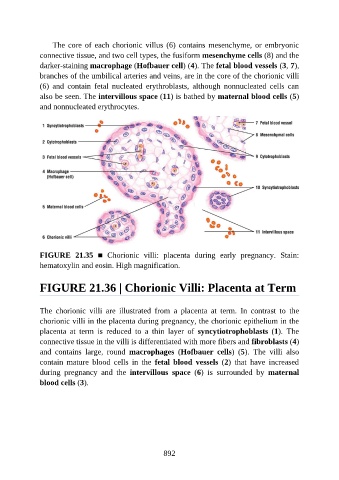Page 893 - Atlas of Histology with Functional Correlations
P. 893
The core of each chorionic villus (6) contains mesenchyme, or embryonic
connective tissue, and two cell types, the fusiform mesenchyme cells (8) and the
darker-staining macrophage (Hofbauer cell) (4). The fetal blood vessels (3, 7),
branches of the umbilical arteries and veins, are in the core of the chorionic villi
(6) and contain fetal nucleated erythroblasts, although nonnucleated cells can
also be seen. The intervillous space (11) is bathed by maternal blood cells (5)
and nonnucleated erythrocytes.
FIGURE 21.35 ■ Chorionic villi: placenta during early pregnancy. Stain:
hematoxylin and eosin. High magnification.
FIGURE 21.36 | Chorionic Villi: Placenta at Term
The chorionic villi are illustrated from a placenta at term. In contrast to the
chorionic villi in the placenta during pregnancy, the chorionic epithelium in the
placenta at term is reduced to a thin layer of syncytiotrophoblasts (1). The
connective tissue in the villi is differentiated with more fibers and fibroblasts (4)
and contains large, round macrophages (Hofbauer cells) (5). The villi also
contain mature blood cells in the fetal blood vessels (2) that have increased
during pregnancy and the intervillous space (6) is surrounded by maternal
blood cells (3).
892

